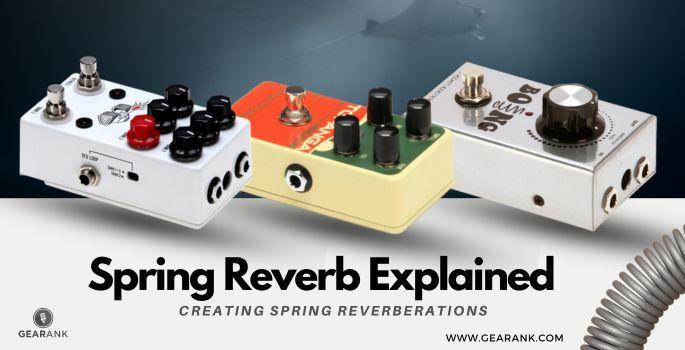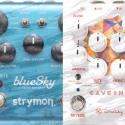Spring Reverb Explained

Spring reverb is one of my favorite pedals. If you want to know how you can use this little beauty to give your music depth and space, I’ve got you covered.
Here you'll learn:
Whether you're a pro or a curious enthusiast, you will get some fresh insights. So make sure to read to the end.
What is a Spring Reverb
Have you ever accidentally bumped into an old amp and heard a weird noise? That bouncy, thunderclap-like noise is the spring reverb inside your amp.
Most vintage-style amps often come with a built-in spring reverb. You'll likely see a small rectangular box if you open it up. This reverb tank, or box, houses a spring reverb unit.
A spring reverb does not emulate natural spaces like rooms or halls. Instead, it produces a luscious, almost echo-like sound. This creates a unique sense of depth and space in a recording.
Like a plate, a spring reverb is considered a "mechanical reverb" since it uses a piece of metal (a spring) to achieve a reverb effect.
Its operational principles resemble those of a plate reverb. Its only key distinction is that it uses metallic springs instead of a sheet metal plate.
These springs are held under tension. The spring's vibration generates reverb-like tails or delays that have metallic tone. This sequence of delays imitates the series of reflections captured in natural reverberation. As it adds to the original audio signal, it creates the illusion of space.
Origin
In 1939, Laurens Hammond developed and applied for a patent for his mechanical spring reverb system.
Interestingly, in 1960, the Hammond organ began using it. This was mainly for their church organ.
This Reverb system was later sold separately as the Accusonics Type 4.
The simple construction made it cheap to produce and compact. Consequently, the Accusonics Type 4 surged in popularity during the 1960s.
In 1963, Leo Fender incorporated it into his Vibroverb Amp. Being so small, these string units were easy to fit inside a guitar amp. Subsequently, Moog and Buchla also adopted it for their synths.
To this day, it has been one of the most well-known and successful forms of reverb.
How Does Spring Reverb Work?
-
Components: Spring tank contains transmission springs known as output and input transducers.
These springs have an electrical transducer on both ends. On one side, it converts the electrical signal to the physical movement of the springs, and on the other, it converts it back to electrical signals.
-
Electrical Signal->Motion->Sound: Imagine a ball bouncing from one corner to the other. With each bounce, the ball loses momentum until it eventually stops.
The same is true in a spring reverb: the electric signal is fed to the springs and travels back and forth, bouncing and layering. It gradually loses energy until it disappears.
This movement creates the illusion of echoing sound, characteristic of spring reverb.
-
Frequency/Pitch = Quality of Sound: Higher frequencies have shorter wavelengths. They will struggle to travel through the unit. Meaning they can only move a single coil or spring at a time. Producing less high-end.
Lower frequencies have longer wavelengths. They won't struggle to travel through the unit. Meaning they can move all the springs at once with ease. Producing more low-end.
-
Input impedance and Output impedance: Different tanks will have different impedance. If you're using an Accusonic Reverb, you can see the impedance on the tank itself.
If not, you can manually check it using a multimeter or an ohmeter. Find the input and outer channel. Then, put the two probes on both sides of the input and output signal terminal to get the values.
What Does a Spring Reverb Sound Like?
A spring reverb imitates the sound of space while adding a few nuances to it. It adds reverb trails to the direct sound source, which allows you to perceive sound in a different space.
Have you ever heard a whip-like sound accompanying a recording? You may have heard it if you listen to surf music. Most recently, it's a characteristic sound in the intro of "Slow Dancing in a Burning Room" by John Mayer. That trailing bouncy sound is what characterizes a spring reverb sound.
Compared to the direct sound, the spring reverb sound has more prominent low-end frequencies, giving off a darker sound.
Uses Of A Spring Reverb
I use spring reverb in a lot of my mixes to add space. It also adds a distinct color to your sound.
Here are some applications of it:
-
Guitars - It makes a guitar tone pop from a busy mix with its unique sound. A lot of high-quality
-
Vocals - The layered frequency response of springs adds dirt to a vocal recording. It adds an edgy feel to the sound, which is great for genres like rock.
-
Amps - Amp spring units have the most organic feel to them. Since many electric guitar amps have built-in spring tanks, you can add this effect to create a live feel and even mimic some iconic tracks.
-
Percussion - Drums, specifically snare drums, and other percussion instruments can benefit from the bouncy sound of a Spring Reverb
-
Mixing - Spring reverb blends well with other effects because it isn't a natural reverb. So, when mixed with other time-based effects, they pop out of the mix. You can here this effect used in a wide variety of styles, form pop to dub music, rockability to blues rock, and more.
Which is Better, Hardware or Software?
This depends on whether you prioritize convenience over realism.
-
Live Performance: You want to use an actual or analog spring reverb for an organic sound, but this may be inconvenient.
Many pros use spring reverb built into amps for live performances. This is more effective for organic sound than pedals (especially tube amps).
But pedals, like the Strymon Blue Sky Reverb Pedal or TC Electronic Hall of Fame, provide more tone-shaping options. They're not hardware units per se, but since they're actual, physical units you can tweak, they can be considered as such. You can go crazy with the settings and get radical results.
-
Studio Recording: If you're recording in a studio, software or plugins will do just fine, although larger studios can afford to have dedicated reverb tanks as outboard gear.
-
I use software for studio recordings. Although not the same sound, it's a practical option when cutting costs and space. Newer software plugins can emulate an actual spring sound with remarkable accuracy. In many cases, it's hard to tell the difference.
Frequently Asked Questions
What's The Difference Between Plate and Spring Reverbs?
A Spring Reverb sends audio transmissions through a metal spring. It has more prominent lows, and it's fantastic for guitars.
A Plate Reverb, on the other hand, sends audio transmissions through a metal plate. It has more prominent highs and is suitable for vocals and drums.
What Are Input and Output Transducers?
A reverb tank contains multiple transmission springs.
An Input Transducer is a sensor that responds to environmental changes and converts them into a readable electrical signal.
Example: A microphone converts sound waves to electrical signal before transferring them to a preamp.
An Output Transducer is an actuator that behaves in contrast to an input transducer, taking electrical signals and transforming them into another form.
Example: A speaker converting electrical energy to mechanical energy (sound).
Conclusion
Much like the best delay reverb pedals, the spring reverb has a unique sound, which can change the vibe of your music.
Like most musical equipment, understanding how it works helps with creativity as a musician.
The journey of experimenting with sounds and techniques should be as enjoyable as defining your music style.
Try loading up a spring reverb plugin or effect on your gear today to try it out. You may find yourself inspired to play and write in novel ways you haven't before.
Contributors:
Jerome Arcon - Co-writer











